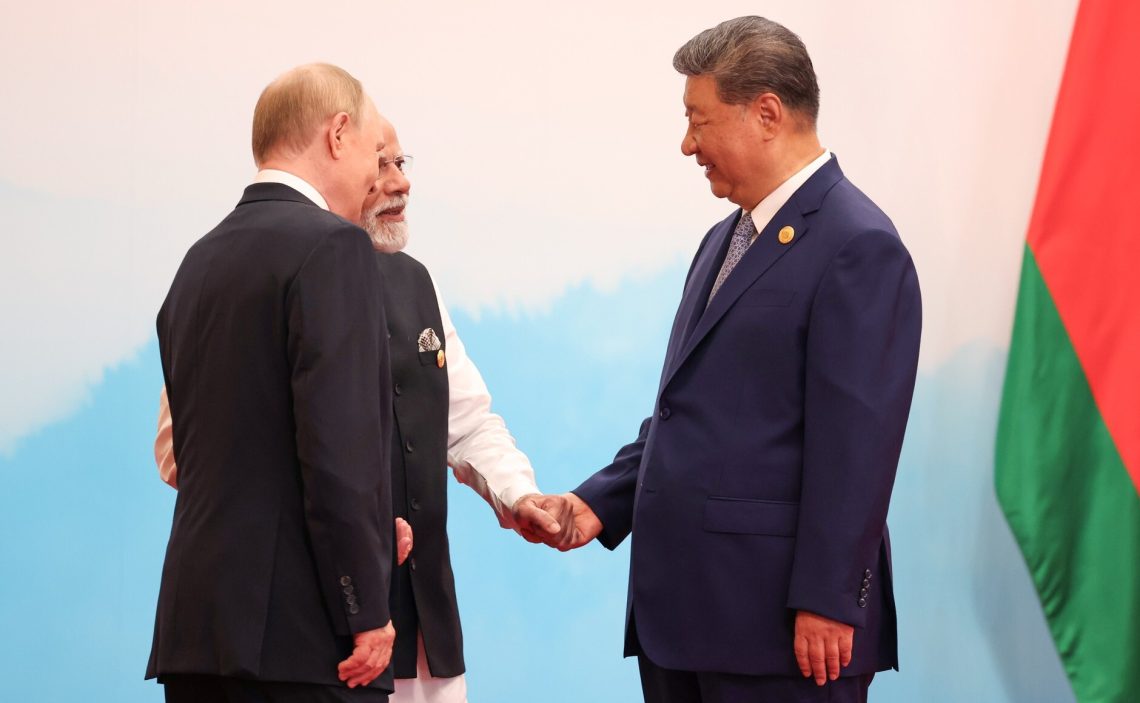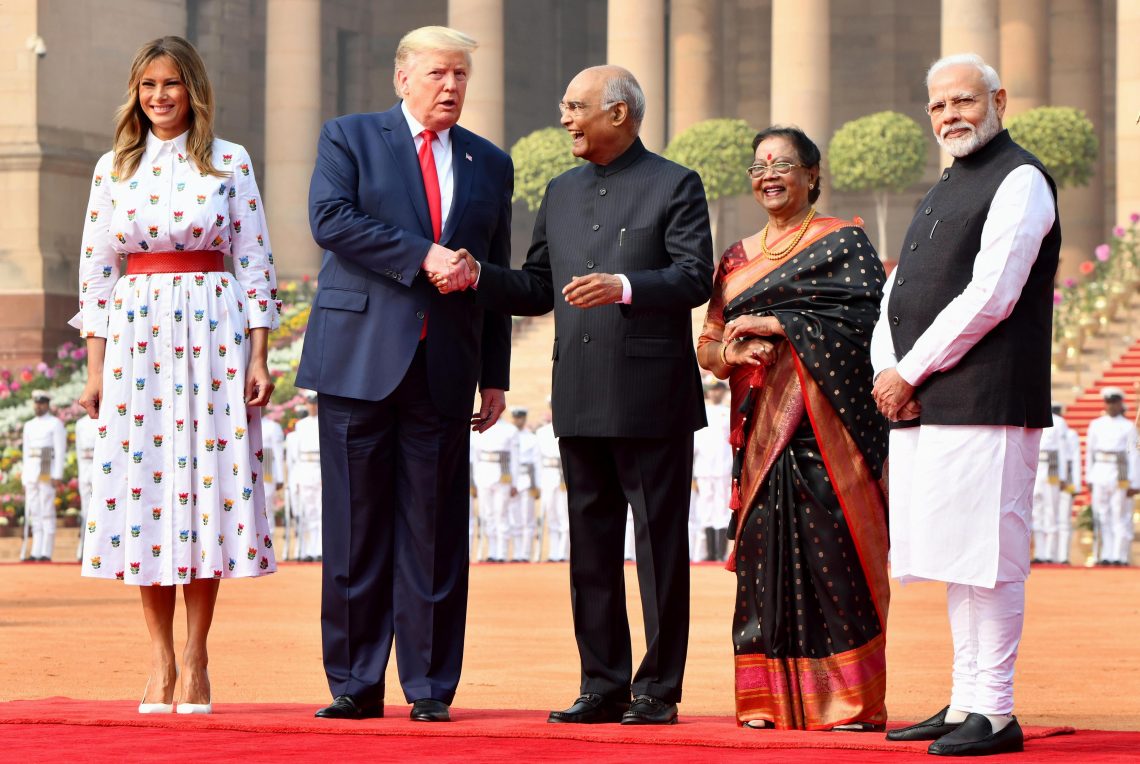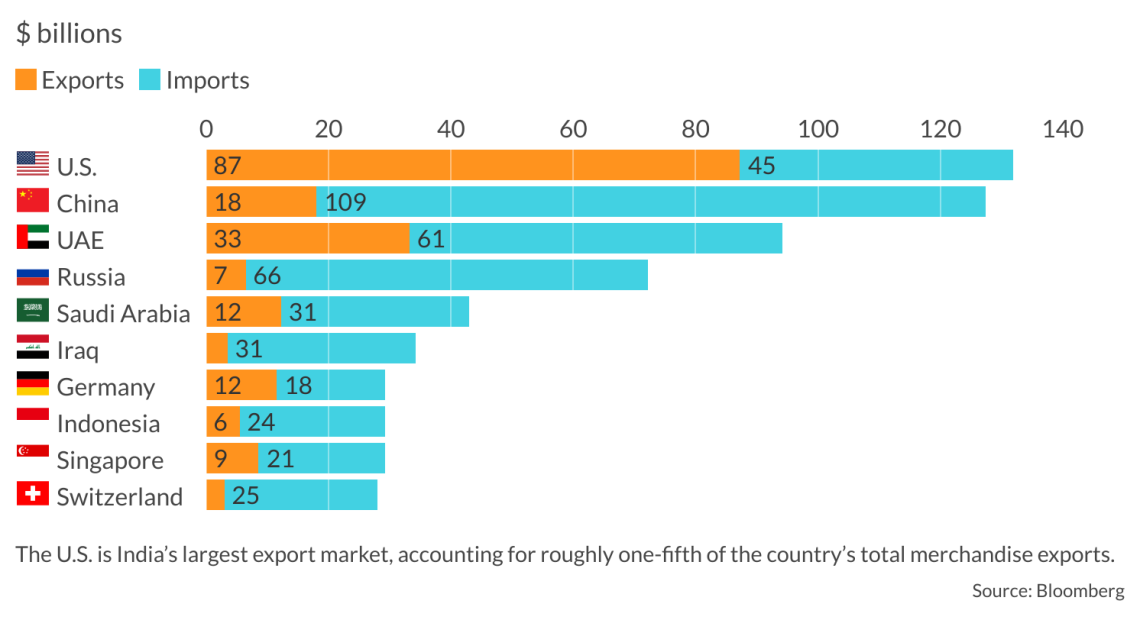U.S.-India embrace turns to transactional tension
Tariffs and shifting relations with Pakistan, along with uncertainties about the Quad, cast doubt on the once-robust U.S.-India partnership.

In a nutshell
- India’s Russia ties, especially military, are a point of friction for the U.S.
- U.S.-India trade gaps highlight untapped potential in economic relations
- Current leadership dynamics make long-term strategic cooperation difficult
- For comprehensive insights, tune into our AI-powered podcast here
This is part 1 of GIS’s series on U.S.-South Asia relations. Part 2 will be available tomorrow.
Despite the occasional warm exchanges of praise between United States President Donald Trump and Indian Prime Minister Narendra Modi on social media and the periodic meetings among high-level officials, the relationship between the two countries is facing its toughest headwinds in decades. India is no longer viewed as America’s key partner for the 21st century and now finds itself sidelined from the second Trump administration’s initiatives, even in its own neighborhood.
Most likely, the current friction is temporary. As the world’s most populous nation, with the fourth-largest economy and military, India remains important to the U.S. Likewise, achieving its economic and security objectives hinges on fostering strong relations with Washington. In the short term, however, India may have to deal with disappointments and invective through the course of the Trump presidency, like other American allies and partners in Europe and Asia.
Shifting U.S. priorities in Trump’s second term
At the start of the second Trump presidency, India was optimistic about being in a prime position to reap benefits over the next four years. Prime Minister Modi was the fourth world leader to meet with the U.S. president, just a month after his second inauguration. New Delhi had a head start in trade negotiations, and the two countries appeared to share a strategic alignment regarding China. India’s arms and oil imports from Russia appeared manageable and U.S.-Pakistan relations were still on shaky ground.
Ten months later, the situation has shifted dramatically. India is the target of the highest tariffs imposed on any major American partner. A majority of Indians perceive the full 50 percent tariffs – comprising a 25 percent baseline and an additional 25 percent penalty on its Russian oil purchases – as “sanction” tariffs reminiscent of the 1970s and 1990s, when the U.S. implemented sanctions linked to its nuclear program. Due to the substantial tariff hike, its exports to the U.S. have seen a significant and ongoing decline, dropping about 37 percent from May to September.
Facts & figures
Four years after the Biden administration pulled troops out of Afghanistan, amid allegations of Pakistani betrayal, the Trump administration seems to have set those tensions aside. Now, it is focusing on strengthening ties with both Pakistan’s civil and military leaders, including a high-profile White House meeting in September with Pakistan’s Prime Minister Shehbaz Sharif and army chief Field Marshal Asim Munir.
This development raises concerns for India, as it fears Pakistan could reemerge as America’s frontline ally in the region. Nevertheless, New Delhi acknowledges Washington’s need for a functional partnership with its regional rival.
Pakistan is a nuclear-armed country located in a critical geography. But it has also fought wars with India and supports terrorist groups that threaten India’s security. Until recently, the U.S. shared New Delhi’s concerns regarding Pakistan, viewing it as a sanctuary for terrorist organizations and a close ally of China. President Trump’s overtures toward Pakistan have complicated the dynamic between India and the U.S.
The two countries have also historically held different views on Russia. For New Delhi, Russia acts as a counterbalance to China, while the U.S. views it as a potential geopolitical adversary. Although the Trump administration has a more pragmatic view of Russia, India’s strong ties with Moscow, particularly its oil purchases, have become a point of contention. American officials cite these connections as reasons to exert pressure on the Modi government.
Over the past decade, worries about China’s growing military and economic influence have prompted the U.S. to implement its Indo-Pacific strategy and to revive the Quadrilateral Security Dialogue (the Quad), which includes Australia, Japan, India and the U.S. A semi-isolationist foreign policy and a relatively benign view of China under the second Trump administration have raised concerns about the sustainability of the Indo-Pacific strategy and the long-term viability of the Quad.

Core elements of the U.S.-India ties
Since the 1990s, the Washington-New Delhi partnership has been underwritten by the belief that India’s rise as a major power aligns with America’s national interests. It was expected to serve as a counterbalance to Beijing’s growing influence. India has largely fallen short of this expectation, demonstrating reluctance to open its markets, lagging in modernizing its military and struggling to maintain its leadership role in the region.
Indian leaders believed that an upward trajectory in the relationship was guaranteed. But they overlooked longstanding tensions, stemming from differing histories, geographies and interests. Now, they are learning that the strategic partnership – built over three and a half decades – defied this divergence and should never have been taken for granted.
Their ties have historically rested on three broad dimensions: shared democratic values, commercial interests and defense cooperation. The values-based dimension helped sustain the relationship during the Cold War, despite America’s frustrations with its non-alignment. In recent years, however, liberal Americans have voiced concerns over India’s democratic backsliding. Conservative Americans have reacted strongly to limitations on religious freedom, particularly regarding Christian missionaries.
Economics serves as the backbone of America’s most robust partnerships. Given the massive potential of the Indian economy, the U.S. has often found itself frustrated with the limited outcomes it can achieve. U.S.-India bilateral trade grew from $6 billion in 1990 to $212 billion in 2024. By contrast, U.S.-China trade rose from $5 billion in 1980 to $660 billion in 2024 – despite escalating tensions – highlighting the scale of missed opportunities with India.
Unlike China, Indian authorities seem to think that their market size and potential alone will attract foreign investment. American companies looking to enter the Indian market have long encountered various hurdles, such as market access restrictions, excessive regulations and red tape, and inconsistent taxation and industrial policies. The American hope of accessing the large Indian consumer market was always a draw that conflicted with reality.

Since the end of World War II, some in the U.S. have seen India as the natural hegemon in South Asia. While this expectation did not materialize during the Cold War, it reemerged in the 1990s, along with the hope that New Delhi would project power across the Indian Ocean region.
This optimism led to India’s recognition as a “Major Defense Partner” of the U.S., yet American expectations have largely gone unmet. India has not been a significant buyer of U.S. military equipment, having spent just over $24 billion on U.S.-origin defense purchases since 2008. This figure pales in comparison to purchases of other allies.
In any case, India’s hesitancy to join a formal security alliance limits military cooperation. Initiatives like the joint development of next-generation aircraft carriers never took off. As a result, achieving true interoperability remains elusive. Given that Russia is the primary supplier of India’s military equipment, Americans remain concerned about their technology potentially falling into Russian hands.
Friendshoring in the tech sector and technology transfer have been areas of growing partnership. However, these collaborations rely on a strategic understanding that is now floundering. President Trump’s America First economic policy conflicts with Prime Minister Modi’s Make in India initiative, as each aims to cater to its own industrial base.
More on Trump’s world order
- Tariffs bring adjustments, not global economic ruin
- Understanding President Trump’s China strategy
- The Global Majority’s push for a multipolar order
Finally – and most importantly – going back to the Cold War, American global strategy has often clashed with India’s regional interests. In the past 35 years, both nations have made considerable efforts to ensure that U.S. ties with Pakistan, alongside India’s relationships with Russia, do not damage their bilateral ties. Today, these historical connections cast a shadow reminiscent of the tensions of the Cold War era.
Previous U.S. administrations accepted India’s links with the Kremlin, albeit reluctantly, hoping to wean it away from its dependence on Russian defense equipment. The Trump administration seems prepared to push India to exert pressure on Russia to expedite a resolution to the Ukraine crisis.
Since the 1990s, successive American administrations have insulated relations with Islamabad from its ties with New Delhi. But changing geopolitical dynamics in the Middle East have once again made Pakistan favorable to a U.S. administration. President Trump’s occasional offers to mediate on the Kashmir issue, revived after the May conflict between the two South Asian neighbors, irritate India, which is resistant to any third-party involvement in its relations with Pakistan.
In the long run, more forces bind the U.S. and India than divide them. The current problems are the result of conflicting domestic political needs of the two countries’ current leaders. President Trump’s personality and style play a major role in this dynamic. While it is likely that relations will return to a more strategic footing three years from now, the immediate future is bound to be strained.
Scenarios
Most likely: New Delhi-Washington engagement persists amid India’s multi-alignment policy
The most likely scenario is that, during the Trump presidency, India and the U.S. will remain engaged, with intermittent highs and lows. High-level engagements, trade talks and discussions on security issues will continue. India, favoring American investment and technology, will work to ensure that its commercial and technological ties remain strong and on course. In fact, minister for commerce and industry, Piyush Goyal, has said that discussions with Washington are at an advanced stage for a trade deal.
Although there are signs of a thaw in trade relations, Prime Minister Modi chose to avoid two separate multilateral events – the UN General Assembly meetings in September and the ASEAN summit in Malaysia in October – where President Trump was present.
The geopolitical and geoeconomic chaos, combined with worries about the future of American global involvement, is likely to strengthen India’s inclination toward multi-alignment and strategic autonomy. Despite concerns regarding Beijing’s intentions, New Delhi is likely to increase its engagement with China while also maintaining strong ties with Russia. This approach aims to safeguard against the uncertainties posed by an unpredictable U.S. Recent moves, such as Prime Minister Modi’s attendance at the Shanghai Cooperation Organization summit in September, and a planned visit by President Putin to India in December, exemplify this multi-alignment strategy.
India will seek to ease domestic economic pressures from U.S. tariffs by pursuing trade agreements with other nations and promoting local consumption. Despite the imposition of the steep duties, India’s merchandise exports have continued to grow, rising 6.7 percent year-on-year in September, driven by a strategic shift toward new markets. Indian exporters are pursuing opportunities in Asia, Europe and the Middle East.
On the defense front, the country’s diversification and indigenization policy will receive a boost. While the U.S. will continue to be one of India’s defense suppliers, alongside France, Russia and Israel, it will not achieve its long-desired status as the primary supplier.
Less likely: Swift resolution to trade tensions
The less likely scenario is a quick resolution to the trade fracas, leading President Trump to change his stance and once again view India as a crucial global ally. If this shift coincides with an announcement for the next Quad Leaders’ summit, which is supposed to take place in India, it may go a long way toward resetting the partnership. While originally scheduled for 2025, now the earliest this can happen will be in 2026.
Least likely: U.S.-India relations worsen
The least likely scenario is that things worsen on multiple fronts. This would mean that trade negotiations continue to drag on without reaching a resolution. Prolonging the conflict in Ukraine could heighten public pressure from the Trump administration on India regarding its Moscow links.
In this scenario, the administration’s emphasis on the Middle East might lead to increased economic investment and military backing for Pakistan. This would cause the Indo-Pacific strategy and the Quad to be relegated in importance.
Contact us today for tailored geopolitical insights and industry-specific advisory services.










